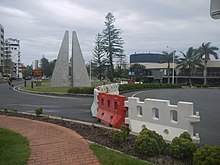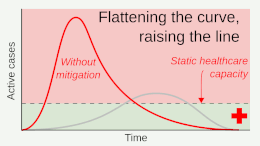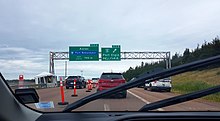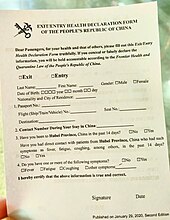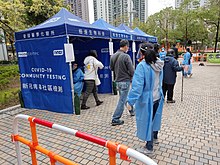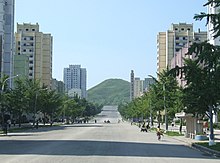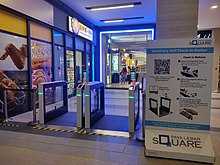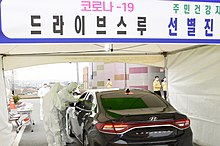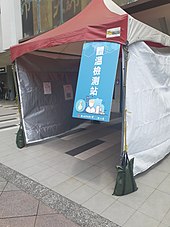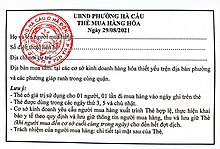Zero-COVID
[1] Public health measures used to implement the strategy included as contact tracing, mass testing, border quarantine, lockdowns, and mitigation software in order to stop community transmission of COVID-19 as soon as it was detected.
[18] Opponents of zero-COVID argued that, similar to the challenges faced with the flu or the common cold, achieving the complete elimination of a respiratory virus like SARS-CoV-2 may not have been a realistic goal.
[4][22][23] Mitigation strategies (also commonly known as "flattening the curve") aimed to reduce the growth of an epidemic and to prevent the healthcare system from becoming overburdened, yet still accepted a level of ongoing viral transmission within the community.
[4] By contrast, elimination strategies (commonly known as "zero-COVID") aimed to completely stop the spread of the virus within the community, which was seen as the optimal way to allow the resumption of normal social and economic activity.
[22][4][24] The zero-COVID approach aimed to prevent viral transmission using a number of different measures, including vaccination and non-pharmaceutical interventions such as contact tracing and quarantine.
[25][26] International flights to China were heavily restricted, and incoming travelers were required to undergo PCR testing and quarantine in designated hotels and facilities.
[28] In order to minimize the risk that these close contacts posed for outbreak containment, China implemented quarantine in centralized facilities for those deemed to be at the highest-risk of infection.
[28] Community-wide screening was intended to rapidly isolate infected people from the general population, and to allow a quicker return to normal economic activity.
[41][42][43] Distinctive aspects of that response included early interventions to reduce reflected transmission from countries other than China during late January and February 2020; early recruitment of a large contact tracing workforce;[44] comparatively high public trust in government responses to the pandemic, at least compared to the United States;[45] and later on, the use of short, intense lockdowns to facilitate exhaustive contact tracing of new outbreaks.
[55] By August 2021, amid outbreaks in New South Wales, Victoria, and the ACT, Prime Minister Scott Morrison conceded a return to Zero-COVID was highly unlikely.
[56] Over the following months, each Australian jurisdiction began a living with COVID strategy either through ending lockdowns or voluntarily allowing the virus to enter by opening borders.
[60] On 24 June 2020, it was announced that the four Atlantic provinces: New Brunswick, Prince Edward Island, Nova Scotia, and Newfoundland and Labrador had come to an agreement of creating a free-travel bubble while maintaining low case numbers inside, effective 3 July 2020.
"[4] The China CDC rejected a mitigation strategy, and instead explained that "[t]he current strategic goal is to maintain no or minimal indigenous transmission of SARS-CoV-2 until the population is protected through immunisation with safe and effective COVID-19 vaccines, at which time the risk of COVID-19 from any source should be at a minimum.
[72] In 2022, China faced unprecedented waves of infections caused by the Omicron variant and subvariants, with daily cases reaching record highs in the thousands—levels not seen at any prior point in the pandemic.
[81][82][83][84][85] Nationwide protests broke out in late November 2022 amid growing discontent among residents over the zero-COVID policy after the 2022 Ürümqi fire and the resulting economic costs.
[89][90][91] On 12 December, the Chinese government announced it was taking offline one of the main health code apps, which was key in tracking people's travel history to identify whether they had been to high-risk areas.
[98] In a study published in April 2020 in the Lancet, the authors expressed their belief that border restrictions, quarantine and isolation, social distancing, and behavioural changes likely all played a part in the containment of the disease up to the end of March.
[101] Measures taken in response included a suspension of school classroom teaching until the end of the year, and an order for restaurants to seat only two persons per table and close at 10:00 p.m. taking effect on 2 December;[102] a further tightening of restrictions saw, among other measures, a 6:00 p.m. closing time of restaurants starting from 10 December, and a mandate for authorities to order partial lockdowns in locations with multiple cases of COVID-19 until all residents were tested.
[108] The massive death toll and high infection rates while maintaining strict eradication protocols led to the calls for authorities to review Hong Kong's Zero-COVID strategy, as well as questioning the sustainability of such an approach with the Omicron variant.
[113] After nine consecutive days of no local cases and over 14 rounds of mandatory mass testing, Macau reopened in what the city's government called a "consolidation period".
Rodong Sinmun, the Workers' Party of Korea newspaper, reported that the customs officials at the port of Nampo were performing disinfection activities, including placing imported goods in quarantine.
[178][179] The high transmissibility of the Delta and Omicron variants challenged Singapore's Zero-COVID approach, and the country phased it out after vaccinating the majority of its population in October 2021.
[188] The South Korean government has also been sending daily emergency notifications, detailing information on locations with reported infections and other status updates related to the pandemic.
[199] In April 2022, the government departed from Zero-COVID, launching a revised strategy—billed as the "new Taiwanese model"—that no longer focuses on total suppression, but rather shifts to mitigating the effects of the pandemic.
[206] To keep the country virus-free, an Australian aid flight had to return to base after detecting a case midflight, while HMAS Adelaide (L01) made plans to stay at sea after 23 members of her crew tested positive for COVID-19.
[214] This success has been attributed to several factors, including a well-developed public health system, a decisive central government, and a proactive containment strategy based on comprehensive testing, tracing, and quarantining.
In response, government-mandated quarantine for foreign arrivals and close contacts to confirmed cases was extended to 21 days, and accompanying safety measures also tightened up.
[220][221] Proponents of the zero-COVID strategy argued that successful execution reduced the number of nationwide lockdowns needed,[222] since the main goal was focused on the elimination of the virus.
[232] In May 2022, World Health Organization director-general Tedros Adhanom Ghebreyesus commented that the zero-COVID strategy was no longer considered sustainable based on "the behavior of the virus now" and future trends.
[230] Singapore abandoned zero-COVID in August 2021 after the Delta variant started spreading there, Australia and Vietnam reopened their borders in early 2022, and China—the last major country to hold out on zero-COVID—abandoned its policy on December 7, 2022.

